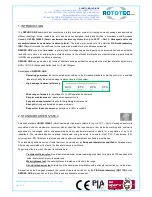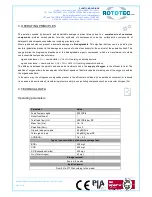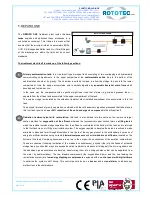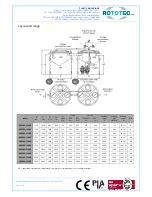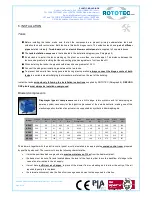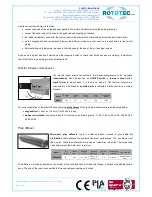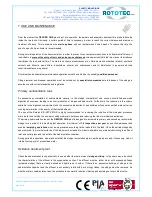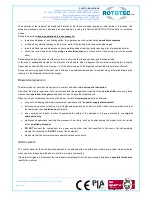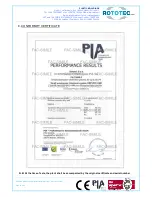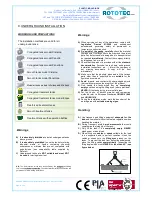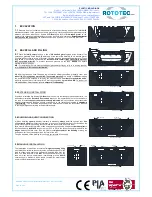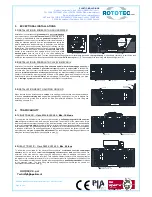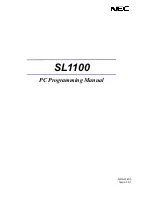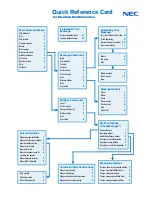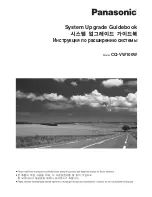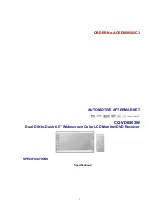
PLASTIC MOULDINGS
V
IA DELL
’
ARTIGIANATO
,
6
•
61026
LUNANO
(PU)
•
I
TALY
T
EL
.
+39
0722
722801
•
F
AX
+39
0722
70599
•
W
EB
:
www.rototec.it
E-
:
•
PEC
VAT
and TAX
CODE
01476690415
•
C
OMPANY
C
APITAL
.
120.000,00
CCIAA
(C
HAMBER OF
C
OMMERCE
R
EG
.
N.)
12602
P
ESARO
DEPURO ONE Use and Maintenance Manual, Rev. 00 of 27/01/2016
Page 12 of 13
20/30cm
5mt
60°
1
5
/2
0
c
m
Topsoil
Topsoil
WATER
1)
WATER
3)
WATER
2)
WASHED
GRAVEL 2/6
4)
WASHED
GRAVEL 2/6
5)
TOPSOIL
Washed gravel 2/6
Topsoil
Topsoil
Topsoil
Extension chamber
Topsoil
Topsoil
Topsoil
Washed gravel 2/6
Extension chamber
Washed gravel 2/6
Topsoil
Topsoil
Extension
chamber
Vent pipe
Cover
Concrete
slab
Cover
Concrete
slab
Washed gravel 2/6
Topsoil
Topsoil
Concrete slab
Topsoil
Cover
1.
EXCAVATION
1.1
Excavate a hole of suitable dimensions with a flat bottom, leaving a space of at least 20/30
cm around the tank. In the presence of heavy ground (e.g. clayey subsoil and/or groundwater) the
distance must be at least 50 cm.
Spread a 15/20cm deep layer of 2/6 washed gravel on the
bottom of the excavation to allow the tank to rest on a uniform and level base. Excavated material
must not be used as backfill. The excavation must be a minimum of 1 m from any structures.
2.
BACKFILL AND FILLING
2.1
Place
the totally empty tank
on a bed of 2/6 washed gravel spread at the bottom of the
excavation, gradually fill the tank with water and at the same time backfill with 2/6 washed gravel.
Continue with successive layers of 15/20cm, filling the tank and then backfilling with gravel. Fill the
tank to 3/4 of its capacity and backfill the last 40cm with topsoil (NOT clayey/limey material,
NOT excavated material). To prevent excessive pressure on the tank, NEVER use backfill
material with sharp edges.
N.B. For installation in more severe conditions (groundwater, clayey soils or in sloping ground),
refer to chapter 3 “Exceptional Installation”.
2.2 After the tank has been filled and the excavation suitably backfilled, gradually cover with
topsoil (NOT clayey/limey material, NOT excavated material) to a depth of 30/40cm, leaving
the inspection covers exposed. In this way, the area concerned is suitable for pedestrian traffic,
while the transit of motor vehicles within 2 m of the excavation is prohibited. N.B. To render the
site trafficable by motor vehicles, refer to chapter 4 “Trafficability”
2.3 EXTENSION INSTALLATION
If the tank is installed at a depth of 30/40cm and the site is to remain open to pedestrian traffic, it is
advisable to install the Rototec PE extension directly on the inspection holes. In the case where
the tank is installed deeper than that previously indicated, which constitutes an unfavourable
and not recommended condition, adhere scrupulously to the instructions reported in chapter 4
"Trafficability". The technician responsible for the installation will follow the instructions reported
in the two paragraphs according to the installation depth.
2.4 PUMP/BIOGAS VENT CONNECTION
a) When installing a pump, whether internally or externally, always install an open-air vent, free
and correctly sized to prevent the formation of a vacuum and deformation of the tank when the
pump is running. After connecting the vent, make the connections and check them.
b) In order to prevent the formation of bad smells and, consequently, enable the treatment plant to
function efficiently, ALWAYS connect a pipe (PVC or PE) to the connection point provided for the
biogas vent on the tank cover. Run the pipe to the highest point of the building or along the
downpipes, but in any case higher than the level of the roof.
The pipe indicated on the drawing for venting is not included in the supply.
2.5 MANHOLE INSTALLATION
The installation of manholes or covers of weight exceeding 50kg
must always be solid with the concrete slab, suitably designed for the
load to support and exerting a uniformly distributed load over the
tank. The slab, therefore, must NOT be constructed directly on the
tank but must rest on undisturbed, load-bearing ground. AVOID
constructions in brickwork which would compromise maintenance
and/or eventual replacement of the tank.


